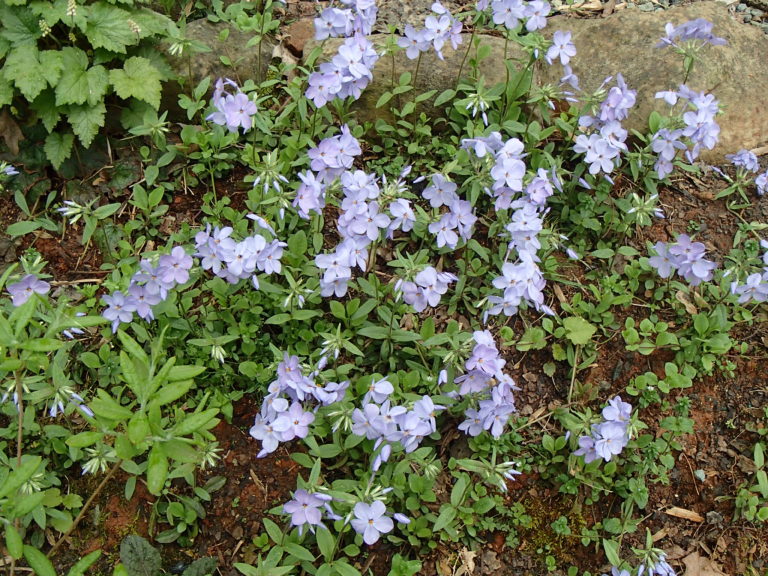Phlox stolonifera, or Creeping Phlox, is a low-growing Phlox found in rich deciduous woodlands, along stream banks and shaded rocky slopes mostly in the Appalachian Mountains from Pennsylvania to Georgia. Unlike the other ground-hugging Phloxes, therefore (which hale from more xeric locales), this one thrives in shady and semi-shady niches on rich, humus-rich but well drained soils. Like all the Phloxes, the flowers of Creeping Phlox are long-tubular, with a flattened presentation of the five petal lobes at the top. Consequently, they support long-tongued pollinators, mostly butterflies and even hummingbirds. Like Phlox divaricata, Creeping Phlox has both fertile and infertile (vegetative) stems. The vegetative stems form colonies from short rhizomes and by rooting at the nodes of decumbent shoots, which also branch to form flowering or fertile shoots. The flowering fertile shoots die back after producing seed, and the infertile non-flowering stems persist through the growing season, providing groundcover and fueling the following season’s growth. ‘Sherwood Purple’ is a reliable blue/purple genotype of Phlox stolonifera, and the USDA plant distribution map linked below is for the species.
NURSERY HOURS
Wednesday: 10-4 Thursday: 10-6 Friday-Saturday: 10-4 Sunday: 12-4
Phlox stolonifera ‘Sherwood Purple’

Key Info
Scientific Name: Phlox stolonifera Sims cv. 'Sherwood Purple'
Common Names: Creeping Phlox
Family Names: Polemoniaceae (Jacob's Ladder Family)
Plant Type: Herbaceous perennial
Leaf Retention: Semi-evergreen
Flower Color: Lavender, blue, rose-pink or white
Special Characteristics: Flowers fragrant, Reported to be deer resistant., Attracts butterflies, Attracts Hummingbirds, Tolerates Black Walnut, Nectar plant, Tolerates shade, Long blooming
Additional Info
Habit: This mat-forming groundcover spreads by self-sowing seed and by stolons. Vegetative (sterile) stems typically form the foliage mat to 3" tall, spreading indefinitely by rooting in at the nodes of prostrate stems to form large colonies. The leafy stems also give rise to the upright flowering stems 8-10 inches tall. A basal rosette persists in winter in mild climates.
Height: foliage is 3-4"; flowers 9-12"
Spread: Indeterminate
Soil Conditions: Moist, well drained; acidic or alkaline pH; rich, organic soils; drought tolerant when established.
Leaves: Opposite leaves are obovate to spatulate with smooth edges and blunt or pointed tips, up to 1½ inches long and pubescent on sterile stems and ¾ inch on flowering stems.
Flowers (or reproductive structures: Loose clusters (cymes) of showy, fragrant, tubular, blue/lavender flowers with five flat, petal-like, rounded lobes in a circular array up to 1 inch in diameter, surrounding the tube and the yellow exserted stamens. These flowers are borne on stems that are 6–10 in tall rising above the foliage mat.
Fruit: Blooming begins in mid-spring continuing until early summer. Small inconspicuous oval seed capsules follow.
Natural Distribution: Rich deciduous woodlands, stream banks, open woods and shaded rocky slopes mostly in the Appalachian Mountains
USDA Hardiness Zone: 5 to 9
USDA Wetland Indicator Status in NC: not available
Pollination: Long-tongued insects; Swallowtail butterflies, day flying Sphinx moths, Hummingbird moths and Clearwing moths; and hummingbirds.
Wildlife Connections: Plants are somewhat resistant to deer but may be nibbled by rabbits.
Propagation: Propagated by seed, by softwood cuttings taken in late spring or by spring division.
